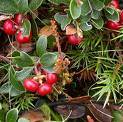Scientific Classification:
|
Other Common Names:
The other common names for the herb uvaursi are Arberry,Bearberry,Bear's-grape,Crowberry,Foxberry,Hog Cranberry,Kinnikinnick,Mealberry,Mountain Box, Mountain Cranberry, Red Bearberry,Sagackhomi,Sandberry and Upland Cranberry.
History

Description


Range
Bearberry is a native to continental Europe. It is distributed over the greater part of the Northern Hemisphere, being found in the northern latitudes and high mountains of Europe, Asia and America. In the British Isles, it is common in Scotland, on heaths and barren places in hilly districts, especially in the Highlands, and extends south as far as Yorkshire; it grows also on the hills of the north-west of Ireland. In America it is distributed throughout Canada and the United States as far south as New Jersey and Wisconsin.Habitat
They preferrs a habitat of heath lands, shady undergrowths and damp conditions. Bearberry is found growing mostly in sandy and gravel rich as well as dry soils in Europe.Cultivation
Autumn is the season for the harvesting bearberry leaves in most areas where the plant is used in herbal medicine. During the autumn, the berries are also sometimes harvested along with the other parts of the plant, and though they are neither tasty nor particularly palatable, these berries are still used as minor fruits by people in some places.Propagation
This herb does not transplant well because the sand falls away from the root in the process and expose them.
Cuttings
Soft wood cuttings 2-5 inches long and deeply planted in pots of sand with little peat, kept moist outdoors or in a cold frame over the winter should be rooted by spring. Longer hard wood cuttings taken in winter may be rooted similarly in the green house.
Layering
By layering in summer in a sandy soil, perhaps in flats.
Seed Collection and treatment
Seed taken from the berries when ripe may be sown 1/2 to 3/4 inches deep in flats of sand and peat, and kept outdoors for two or five years before germination occurs.
Flowering Season
The waxy flowers, which appear in May, are few and are borne in short, drooping clusters at the ends of the branches.Pests and Diseases
No serious insect or disease problems. Some problems with black mildew and rust have been reported. This cultivar has good resistance to leaf spot and leaf gall. Most rusts are host specific and over winter on leaves, stems and spent flower debris. Rust often appears as small, bright orange, yellow, or brown pustules on the underside of leaves. If touched, it will leave a colored spot of spores on the finger. Caused by fungi and spread by splashing water or rain, rust is worse when weather is moist. Plant resistant varieties and provide maximum air circulation. Clean up all debris, especially around plants that have had a problem. Do not water from overhead and water only during the day so that plants will have enough time to dry before night. Apply a fungicide labeled for rust on your plantParts Used
 | The leaves and berries of the herb bearberry are of both medicinal and commercial value. |
Medicinal Applications

- The bearberry herb can prove to be an effective diuretic and may be used as a general urinary antiseptic and treating urinary system dysfunction and gout.
- The leaves and the berries can be used in the preparation of an herbal tea which can effectively help in the treatment of nephritis.
- It is used in long term treatment of arthritis or inflammation of the urethra in women and in the treatment of cystitis, which is an uncomfortable inflammation affecting the urinary bladder of patients.
- The herb has also been used as a general tonic for weakened kidneys, liver or pancreas.
- Uva Ursi also contains allantoin which is well known for its soothing and tissue-repairing properties, and it works best when one avoids acidic foods, such as citrus fruits and juices, cranberry products, sauerkraut and vitamin C.
- This herb helps prevent postpartum infection and is also helpful for chronic diarrhea.
- As a nutritional supplement and muscle relaxant, Uva Ursi soothes, strengthens and tightens irritated or inflamed tissues.
- Uva Ursi 's astringent properties may also assist in the treatment of some bed wetting problems.
- It is used in curing back pains and veneral diseases.
- Uva Ursi leaf is widely used as a diuretic, astringent and antiseptic.
Commercial Applications

- Most of the herbal teas used and marketed in Europe for the herbal treatment of various kidney and urinary bladder disorders contain the bearberry as an active and essential ingredient.
- The berries can be cooked along with other foods and eaten.
Folklore and Myths
Native Americans used it with tobacco and other herbs in religious ceremonies. It was also used as a smudge or a type of incense or smoked in a sacred pipe believing it carried the smoker's prayers to the Great Spirit. When mixed with tobacco, it was referred to as Kinnikinnick, from an Algonquian (probably Delaware) word for "mixture". The Cheyenne used the tea to treat back sprains. Some Native American tribes powdered the leaves and applied them to sores. The berries were also made into a tea that was used to ward off obesity.


